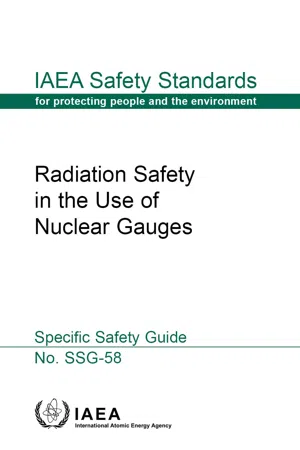1. INTRODUCTION
Background
1.1. As stated in IAEA Safety Standards Series No. SF-1, Fundamental Safety Principles [1]: “The fundamental safety objective is to protect people and the environment from harmful effects of ionizing radiation.” Paragraph 2.1 of SF-1 [1] states:
“This fundamental safety objective of protecting people — individually and collectively — and the environment has to be achieved without unduly limiting the operation of facilities or the conduct of activities that give rise to radiation risks.”
1.2. Paragraph 2.2 of SF-1 [1] states:
“The fundamental safety objective applies for all facilities and activities, and for all stages over the lifetime of a facility or radiation source, including planning, siting, design, manufacturing, construction, commissioning and operation, as well as decommissioning and closure. This includes the associated transport of radioactive material and management of radioactive waste.”
1.3. There are several hundred thousand nuclear gauges incorporating a radioactive source or a radiation generator in use all over the world. They have been used in a wide range of industries [2] to improve the quality of products, optimize processes, and save energy and materials. The economic benefits have been amply demonstrated and there is clear evidence that nuclear gauge technology can be used safely and will continue to play an important role in a wide range of industries.
1.4. There are three main categories of nuclear gauge used in industry [2]:
(a) Transmission gauges, used to measure density, thickness and levels of materials: The source housing and the radiation detector are on opposite sides of the material under investigation and the radiation is attenuated as it travels through the material. Such gauges traditionally used radioactive sources (beta and gamma); however, X ray generators are increasingly being used and are now a popular type of radiation source in transmission gauges.
(b) Backscatter gauges, used to measure the thickness of coatings: The detector and source housing are on the same side of the material and therefore the detector has to be shielded from the primary radiation. The radiation enters the material, interacts with it and scatters back. Radioactive sources (beta, gamma and occasionally neutron) are typically used in such gauges. The back-scattered radiation is measured by the radiation detector and is related to the coating thickness.
(c) Reactive gauges, for example used for elemental analysis: Certain radiation sources (X ray and neutron) can cause fluorescent X ray emissions in the material being analysed. X ray generators and neutron sources (radioactive sources or radiation generators) are used in some reactive gauges.
Annex I presents an overview of the main radiation sources used in nuclear gauges for different applications.
1.5. IAEA Safety Standards Series No. RS-G-1.9, Categorization of Radioactive Sources [3] provides a relative ranking of radioactive sources in terms of their potential to cause severe deterministic effects (i.e. how potentially hazardous they could be if misused). The categorization system set out in RS-G-1.9 has five categories, wherein sources in Category 1 are considered to be the most ‘dangerous’. Radioactive sources used in nuclear gauges normally fall into Category 3 or Category 4.
1.6. This Safety Guide is one of a number of Safety Guides on industrial uses of ionizing radiation, including for industrial irradiators, industrial radiography, well logging and radioisotope production facilities [4–7].
1.7. Unless otherwise stated, terms used in this Safety Guide have the meanings ascribed to them in the IAEA Safety Glossary [8].
1.8. It is assumed in this Safety Guide that an effective governmental, legal and regulatory infrastructure for radiation safety for the use of nuclear gauges is in place in the State.
Objective
1.9. The objective of this Safety Guide is to provide recommendations on how to meet the relevant requirements of IAEA Safety Standards Series No. GSR Part 3, Radiation Protection and Safety of Radiation Sources: International Basic Safety Standards [9] in relation to the use of nuclear gauges.
1.10. The guidance in this publication is aimed primarily at operating organizations that are authorized to use nuclear gauges, as well as their employees and radiation protection officers. The guidance will also be of interest to regulatory bodies, and to designers, manufacturers, suppliers, and maintenance and servicing organizatio...
